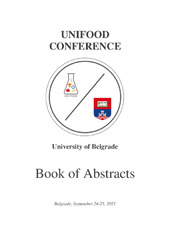Приказ основних података о документу
Investigation of essential oils and their potential use in the food industry and pharmacy
| dc.creator | Drobac, Milica | |
| dc.date.accessioned | 2023-10-11T09:23:37Z | |
| dc.date.available | 2023-10-11T09:23:37Z | |
| dc.date.issued | 2021 | |
| dc.identifier.isbn | 978-86-7522-066-4 | |
| dc.identifier.other | COBISS.SR-ID 47517705 | |
| dc.identifier.uri | https://farfar.pharmacy.bg.ac.rs/handle/123456789/5091 | |
| dc.description.abstract | Essential oils are complex mixtures of volatile compounds produced by aromatic plants and characterized by distinctive, strong fragrance. Essential oils and their constituents are widely used in a number of food products and beverages, primarily as flavoring agents. Due to the antimicrobial and antioxidant properties of essential oils and their components, they may represent a promising natural alternative to chemical preservatives in the food industry. Similarly, the insecticidal/repellent potential of essential oils may be worth exploring in view of food storage. In addition to antimicrobial and antioxidant activity, essential oils demonstrate various pharmacological activities including anti-inflammatory, expectorant, spasmolytic, carminative, diuretic, rubefacient activity and are hence used in the treatment of respiratory, gastrointestinal, skin disorders as well as rheumatism, neuralgia and many other ailments. The investigation of essential oils is a wide field of research addressing different aspects. In light of these considerations, the essential oils of different plants, mainly from the flora of the Balkan Peninsula, were investigated in order to find new sources of raw material and constituents with potential use in the pharmacy and food industry. The study focused on the content, chemical characterization (e.g. Valeriana sp., Anthemis sp.) and evaluation of their antimicrobial (e.g. Thymus sp., Achillea sp., Armoracia sp.), spasmolytic (Ferula sp., Cymbopogon sp.), antiedematous and antihyperalgesic (Matricaria sp., Laserpitium sp.) properties, as well as their insecticidal properties (Cymbopogon sp.). Since many factors have an influence on the composition of essential oils, chemical analyses provide insight into the variability and possible existence of chemotypes, which is important from the aspect of defining raw material and their quality control. Although of natural origin and usually considered safe, some essential oils contain compounds that bear potential risks (e.g. essential oils of Salvia officinalis, Artemisia absinthium, Ocimum basilicum); therefore, the safety aspect of essential oils should not be neglected. | sr |
| dc.language.iso | en | sr |
| dc.publisher | University of Belgrade | sr |
| dc.relation | info:eu-repo/grantAgreement/MESTD/inst-2020/200161/RS// | sr |
| dc.rights | openAccess | sr |
| dc.source | UNIFOOD conference, Belgrade, September 24-25, 2021, Book of Abstracts | sr |
| dc.subject | essential oil | sr |
| dc.subject | chemical composition | sr |
| dc.subject | activity | sr |
| dc.subject | pharmacy | sr |
| dc.subject | food | sr |
| dc.title | Investigation of essential oils and their potential use in the food industry and pharmacy | sr |
| dc.type | conferenceObject | sr |
| dc.rights.license | ARR | sr |
| dc.citation.spage | 14 | |
| dc.citation.epage | 14 | |
| dc.citation.rank | M32 | |
| dc.description.other | Predavanje po pozivu sa skupa međunarodnog značaja: Unifood conference, Belgrade, September 24-25, 2021 | sr |
| dc.description.other | UNIFood2021 Conference, 24th-25th September 2021 University of Belgrade, 2nd International UNIfood Conference | |
| dc.identifier.fulltext | http://farfar.pharmacy.bg.ac.rs/bitstream/id/14084/bitstream_14084.pdf | |
| dc.identifier.rcub | https://hdl.handle.net/21.15107/rcub_farfar_5091 | |
| dc.type.version | publishedVersion | sr |

